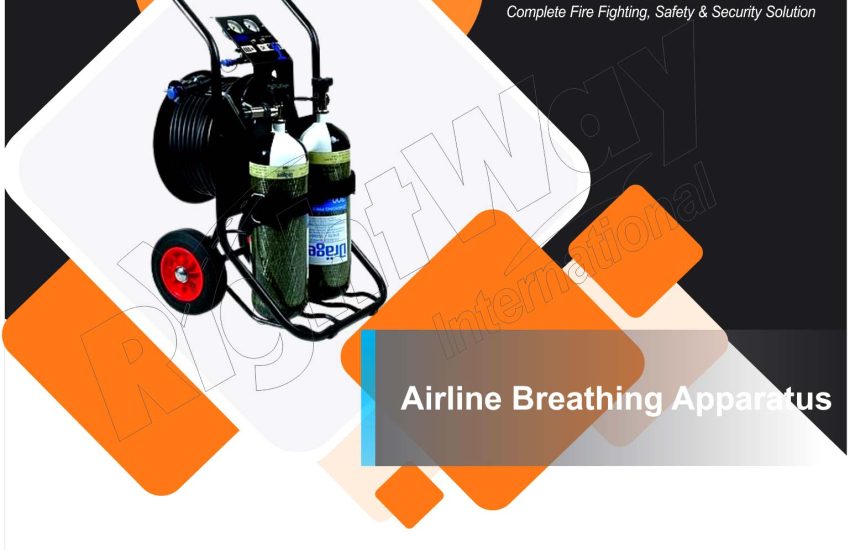Airline Breathing Apparatus (ABA) provides a continuous supply of clean, breathable air from an external source. Unlike self-contained breathing apparatus (SCBA) systems that use onboard air tanks, airline systems connect to a compressed air supply. This connection makes them suitable for prolonged use in environments where a constant air source is available.
1. Purpose and Importance
The primary goal of an airline breathing apparatus is to guarantee that users receive a reliable and uninterrupted supply of breathable air. This is especially important in hazardous environments where the air quality is compromised. Industries and emergency responders rely on these systems in various situations, including:
- Chemical plants
- Confined spaces
- Laboratories
- Emergency response scenarios
By providing a continuous air supply, ABAs significantly enhance safety and reduce the risk of respiratory exposure.
2. Key Components of Airline Breathing Apparatus
A typical airline breathing apparatus consists of several essential components working together to ensure effective respiratory protection:
Air Supply Hose
This hose connects the user’s mask or facepiece to the external compressed air source. It must be durable and resistant to environmental conditions such as abrasion, heat, or chemicals.
Compressed Air Source
Usually a high-pressure tank or stationary compressor, this source delivers breathable air regulated to maintain a steady and safe pressure.
Facepiece or Mask
The facepiece seals tightly around the user’s face to prevent inhalation of contaminants. It often includes a visor for visibility and may incorporate communication systems for coordinated work.
Regulator
The regulator controls airflow from the hose to the user, ensuring that air pressure remains appropriate for comfortable and safe breathing.
Harness
The harness secures the facepiece and air supply components, allowing users to move freely while maintaining comfort.
3. Types of Airline Breathing Apparatus
There are various ABA configurations designed to suit different operational needs:
Continuous Flow Systems
These provide a steady, uninterrupted flow of air to the user’s facepiece. They are ideal in environments where air purity is maintained, and contamination risk is low.
Demand Flow Systems
Demand flow systems supply air only when the user inhales, conserving air and extending the duration of use. They suit situations where air consumption fluctuates.
Purge Valve Systems
These systems include a valve that allows users to flush contaminants out of the facepiece, offering an additional layer of protection.
4. Common Applications
Airline breathing apparatuses find wide application across various industries and emergency services:
- Industrial Environments: Protect workers from exposure to hazardous substances such as chemicals, dust, and fumes in manufacturing, construction, and processing plants.
- Confined Spaces: Provide breathable air in restricted areas where the atmosphere might be compromised.
- Emergency Services: Support firefighters, rescue teams, and other responders requiring a reliable air supply in hazardous conditions.
- Laboratories: Safeguard personnel handling dangerous chemicals or biological agents.
5. Maintenance and Care
Proper maintenance ensures the reliable operation of airline breathing apparatuses. Key practices include:
- Regular Inspections: Check the air supply hose, facepiece, and regulator for signs of wear, damage, or malfunction. Confirm that all parts work correctly.
- Filter Replacement: Replace filters as recommended by manufacturers to maintain air quality and system performance.
- Air Supply Checks: Routinely test the compressed air source for contaminants and verify it meets safety and purity standards.
- Training: Train users thoroughly on correct usage, maintenance, and limitations of the equipment.
6. Safety Considerations
Users must follow these safety guidelines to ensure optimal protection:
- Ensure Proper Fit: Adjust the facepiece to create a secure seal that prevents contaminants from entering.
- Monitor Air Quality: Regularly verify that the air supply remains contaminant-free and meets respiratory protection standards.
- Follow Procedures: Adhere strictly to established safety protocols and training for correct equipment use.
7. Regulatory Compliance
Airline breathing apparatus systems must comply with safety regulations to guarantee their effectiveness:
- Occupational Safety and Health Administration (OSHA)
- National Institute for Occupational Safety and Health (NIOSH)
- European Committee for Standardization (CEN)
- Compressed Gas Association (CGA)
These standards ensure the apparatus meets performance, safety, and reliability requirements.
Conclusion
Airline breathing apparatus systems are essential for delivering a continuous, reliable supply of breathable air in hazardous environments. By understanding their components, applications, and maintenance needs, users can maximize safety and efficiency. Moreover, proper care, adherence to safety standards, and ongoing training remain critical to maintaining the performance and reliability of these respiratory protection systems


